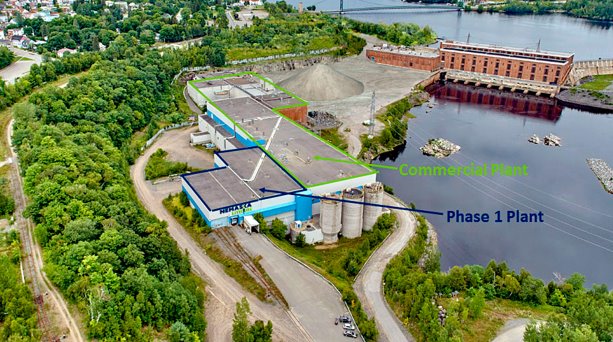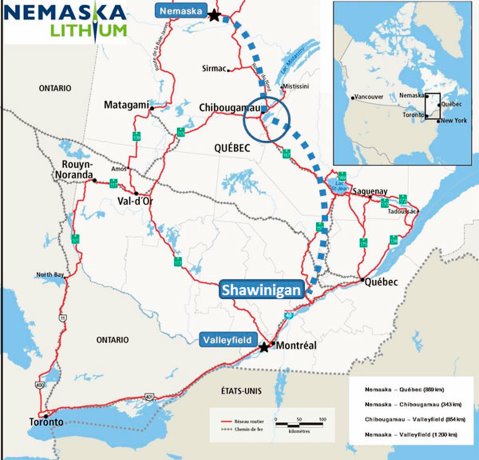At first glance, Quebec’s Nemaska Lithium project looks charmed and its owners the beneficiaries of extreme good fortune.
The project, the viability of which was just confirmed in a feasibility report released April 4, will see spodumene extracted from the firm’s new Whabouchi mine near Nemaska in northern Quebec and reduced in a concentrator the firm will build on site. The spodumene concentrate will then be trucked 317 kilometres south to Chibougamau where it will be loaded on a train destined for Shawinigan, 530 kilometres further south.
There, Nemaska Lithium is building a Phase 1 demonstrator plant to be followed closely by its main 28,000-tonne hydromet plant. The concentrate will be processed primarily into lithium hydroxide, ready for shipment to buyers for production of lithium-ion batteries.
The infrastructure is almost all in place already. The Nemaska Cree First Nation is solidly on board as an economic partner, the Shawinigan site involves a mere retrofit of a recently vacated pulp and paper mill, and the company’s proprietary processing technique that will use hydroelectric power couldn’t be a better fit, given the location of a Hydro-Quebec dam and power plant right on site on the St. Maurice River at Shawinigan, says the president and CEO of Nemaska Lithium.
In reality, luck had very little to do with putting the project together, says Guy Bourassa.
"We are fortunate but sometimes you have to make your fortune," he says.
"You have to be ahead of the crowd and see what is going to be required in the future."
Nemaska’s Whabouchi Spodumene Mine has been shown to hold the world’s second largest and richest deposit of spudomene — the source of lithium — in the world, with 27.3 megatonnes of proven and probable resources, promising an estimated mine life of 26 years.
In 2008, Bourassa says the marketplace was talking about lithium carbonate as being the compound of the future for larger batteries. But his team took a step back, talked to end users and determined lithium hydroxide was the way to go.
"Mining analysts were laughing, they said we were not understanding the market," he says. They laughed again in 2014 when the proposed size of the plant was upped to 28,000 tonnes, he adds.
"But that was confirmed to be a good decision when Tesla announced it was going to build its own giga factory to feed 500,000 vehicles with batteries."
Tesla uses lithium hydroxide. Lithium hydroxide batteries offer more capacity and a have longer lifecycle than other compounds, says the Nemaska Lithium feasibility study.
The next risk was deciding on the refining process. The traditional method using chemicals shipped in and out is wasteful, says Bourassa. And so Nemaska Lithium consulted experts in the U.S. and Germany and right at home at Quebec’s Centre National en Electrochimie et Technologies Environnementales and came up with its innovative hydroelectric refining process. The commitment to this greener process has prompted the federal and Quebec governments to invest $38 million on the Phase 1 plant.
"We are very excited about the fact that we are able to confirm the very low cost of production," said Bourassa. "A greener way of making hydroxide and at a lower cost, that is amazing."
The smaller Phase 1 plant is being built to fine-tune the production process and allow potential customers to test the lithium hydroxide produced, says Bourassa; it will remain in production after the larger plant is built.
The timetable will see Phase 1 started imminently and commissioned by the end of 2016, with product sent to customers on a small scale early in 2017. The mine in Nemaska and the concentrator will be completed by the end of 2017. Construction of the larger commercial plant will begin in 2017 with a spring 2018 completion date foreseen. Full-scale production starts the third quarter of 2018.
Capital costs for the project will include $249 million spent up north developing the mine, building the concentrator, putting up 13 kilometres of a 69-kilovolt electricity line from Nemaska to connect to the existing Hydro Quebec grid and building a garage. Bourassa expects to see 250 construction workers employed over 14 months at Nemaska, many from the Nemaska First Nation.
Another $300 million will be spent on capital in Shawinigan. Bourassa expects 150 construction workers to be employed over two years at that site.
In terms of a permanent workforce, it is estimated there will be 185 required in Nemaska, 16 in Chibougamau and 110 in Shawinigan.
Met-Chem is the engineering firm overseeing the mine site, while Seneca Engineering has been chosen to work on the Shawinigan build. No contractors have been selected yet.
Testing consultants have included Met-Chem, Seneca, SGS Geostat, Noram Engineering & Construction Ltd. and Equapolar Research.
Bourassa describes negotiations with the Nemaska Crees and the broader Cree Nation since 2009 as "open, frank" and leading to an "ongoing, lasting relationship." In 2014 the Chinuchi Agreement was signed, aiming to offer environmental assurances and economic benefits.
Demand will be no problem.
"I think will have 45 to 50 per cent of the output of the commercial plant committed by the end of this year," Bourassa says. "If we had products today, we would be selling all of it."
Because they have lithium in the company name, says Bourassa, they are getting about five cold calls a week from India, China, South Korea and the United States.

1/2
Shawinigan, Que. was selected as the site for the Nemaska Lithium’s Phase 1 demonstration plant and the larger hydromet plant, both capable of producing high-purity lithium carbonate and lithium hydroxide, in September 2015. Valleyfield, Que. was the original choice. The property along the St. Maurice River was the long-time site of the Laurentide pulp and paper plant and is already serviced with a rail connection and access to a Hydro-Quebec hydroelectric plant.
Photo: Nemaska Lithium











Recent Comments
comments for this post are closed